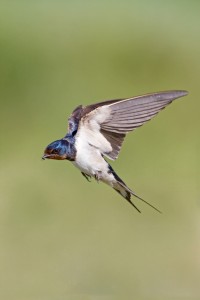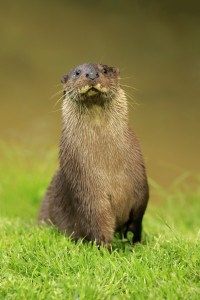Wildlife Habitats & Best Places for Wildlife

Post Office Field
There are many places in and around Ennis that form a habitat for wildlife including wetlands woodlands, grassland, rivers and lakes. Here is a list of just a few of them that we encourage you to discover.
The Post Office Field is a wonderful natural asset located adjacent to the historic town of Ennis in a broad meander of the River Fergus. The low-lying ground, extending to around 1.6ha, is a natural floodplain for the River, providing natural flood control capacity for the town. The field contains a mosaic of wetland habitats including wet grassland, willow scrub and tall herb swamp. Many wildflowers can be seen in the field during the summer months including Meadowsweet, Purple Loosestrife and Yellow Flag along with rushes and meadows grasses.
Tim Smyth Park/The Fairgreen
Tim Smyth Park in the Fairgreen is a popular amenity with playing pitches, running track and a playground. Surrounded by trees and scrub, this is a great green space in the town to escape for a while and relax.
Ballyalla Lake is a population recreation amenity with picnic tables and a swimming area. A 6km Slí na Sláinte route starts in the car park. Ballyalla Lake is a relatively small, shallow lake situated on the River Fergus approximately 4 km north of Ennis. It is a naturally eutrophic lake, a habitat listed on Annex I of the EC Habitats Directive1 reflecting its importance in a European context. The site contains a mosaic of woodlands, wetlands, waterbodies and limestone pavement, which adds to the diversity of the site. Wetlands are key to maintaining water quality as well as supporting wildlife. Ballyalla Lake is also a Special Protection Area (SPA) under the EC Birds Direc
tive2. The lake and the floodplain to the west hold nationally important numbers of Shoveler, Wigeon, Coot, Mallard and Gadwall. Significant numbers of Whooper Swan also uses the site. Other regular wintering species include Teal, Lapwing, Tufted Duck, Pintail and Little Grebe. Ballyalla Lough is also a Ramsar Convention3 site and a Wildfowl Sanctuary4. An attractive interpretive panel highlights many of the birds that can be seen at the lake. For a relatively small lake, Ballyalla supports huge numbers of water birds and is therefore extremely valuable for wildlife. It is a great spot for birdwatching. The Clare branch of BirdWatch Ireland run birdwatching outings at the lake most years.
Rocky Road
The Rocky Road is an ancient pilgrim path that runs from Ennis through Cahircalla Beg to a holy well at Killone Abbey on the shore of Killone Lake (St. John’s Well). The path travels through a limestone landscape with Hazel scrub, native woodand, limestone pavement, calcareous grassland and lake shore. The flora and fauna of much of this area is reminiscent of the Burren. The Rocky Road is a popular walking and running route. The final section of the route to Killone is overgrown but the road can be enjoyed along with the paths in Ballybeg Wood.
Drumcliff Old Graveyard
As a place of burial, Drumcliff has a long history, dating back to the early monastic settlement established there some time before the tenth century, and whose remains still dominate the elevated part of the graveyard site. Old graveyards such as Drumcliff can be havens for wildlife as well as places of remembrance and quiet reflection for the local community.
The River Shannon and Fergus estuaries form the largest estuarine complex in Ireland and support more wintering wildfowl and waders than any other site in the country. Most of the estuarine part of these rivers has been designated a Special Protection Area (Shannon and Fergus Estuaries SPA) based on the important populations of overwintering birds that utilise these areas. The River Fergus is also part of the Lower Shannon SAC, which contains many important wetland and aquatic habitats and species. The Fergus brings nature and wildlife into the town centre. Much of the river edge is fringed with wetlands, which provide food and cover for numerous birds, Otters and fish. There are two significant tributaries of the Fergus in the town, which also have a value for wildlife, the Claureen and the Gauras.
Ballybeg Woods
There is a large area of woodland just south of Ennis, some of which is known locally as Ballybeg Wood. Ballybeg has been developed as a natural amenity under the Neighbourwood Scheme and there is a network of walking trails to enjoy. The majority of the site is mixed broadleaved woodland
with Ash and Beech in the canopy, and Hazel in the understorey. A lucky walker might hear a Long-eared Owl while strolling through the wood or spot a Red
Squirrel. Ballybeg Wood and the nearby woodland and caves at Newhall and Edenvale are considered to be one of the best sites for the Lesser Horseshoe Bat in Europe. These bats are very rare in a European context and are protected under Irish and EC law.
Lees Road Sports Amenity Park
The Lees Road Sports and Amenity Park is a large sports and recreation amenity with playing pitches, a skateboard park and running tracks. The facility is surrounded by a large area of woodland, much of which is broadleaved with some native stands of Ash, Hazel and Oak. Moss covered limestone boulders are strewn across the woodland floor. Trails weave through the woodland and providing a great resource for walkers and an opportunity to enjoy nature.



